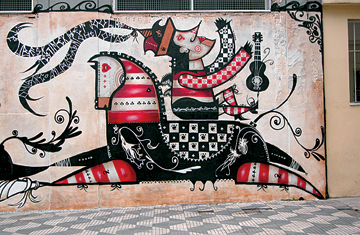
Street art Graffiti goes inside
When it starts inspiring the motifs that adorn designer handbags, graffiti's entrée into the world of mainstream culture is no longer in doubt. It is in this spirit that the expansive exhibition "Born in the Streets — Graffiti," which runs until Nov. 29 at the Fondation Cartier in Paris, is being held. At the same time, curator Thomas Delamarre says that he isn't about to "hang some canvases on the wall and say, 'That's graffiti.' Graffiti exists because it was born in the street."
The show recounts the art form's inexorable spread, from the New York City tenements of the 1970s to the streets of São Paolo in 2009. Pioneers like PHASE 2 and Seen, who by the 1980s were transforming New York subway cars into traveling canvases, here reproduce their works in full scale. Pieces by Jean-Michel Basquiat and Keith Haring from the same period reveal graffiti's impact on fine art. Rare films and headlines describe the deaths (spray-painting on busy subway lines is hazardous) and municipal cleanup efforts that ended graffiti's golden age, at least in New York, by 1989.
Graffiti has since spread far beyond New York's boroughs, and its cross-fertilization with other art forms and traditions around the world is highlighted through original works by seminal street artists like Dutchman Boris Tellegen, who draws on his design background to create three-dimensional, industrial landscapes, and Brazilian Vitché, whose elaborate mural paintings evoke Indian and Aztec culture.
Hervé Chandès, the Fondation Cartier's director, calls graffiti "a dance with the walls, with the night, with the police." As this exhibition proves, the dance is still evolving. See fondation.cartier.com for details.
